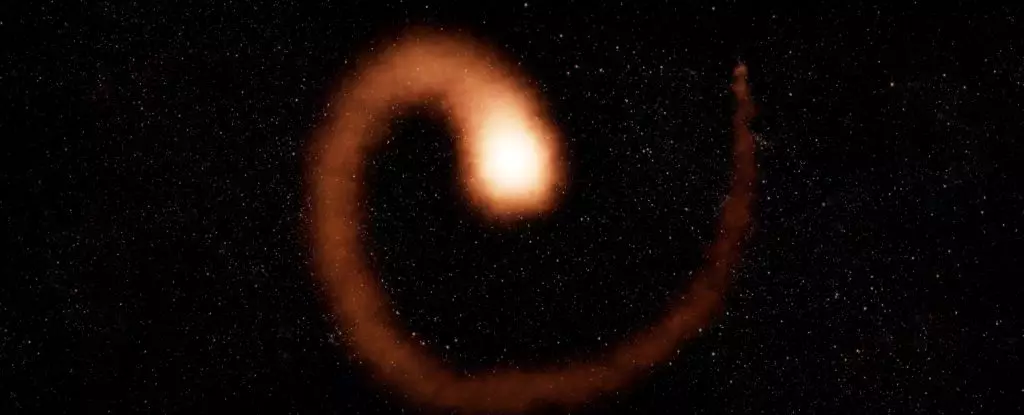In the vast expanse of our universe, stellar evolution paints a narrative that is both captivating and alarming. A prime embodiment of this cosmic tale is Wolf-Rayet 104 (WR 104), a fascinating star system situated thousands of light-years from Earth. Known affectionately as the Pinwheel Nebula, this stellar duo plays out a dramatic performance of cosmic death, highlighting the intricacies of star interactions, mass loss, and the exquisite beauty of their ejected material.
Wolf-Rayet stars like WR 104 are at the terminal phase of their life cycles, characterized by their immense mass, fiery luminosity, and the final ejection of stellar material as they approach supernova. Unlike our Sun, which will expand and transform slowly into a red giant, WR 104 embodies a hurried transformation, encapsulated in just a few million years. An intriguing observation presents itself with the discovery that WR 104 exists in a binary system, interacting closely with a companion star, leading to the formation of a stunning spiral structure that defies expectations.
The Significance of Stellar Companionship
The dynamics of binary stars have always intrigued astronomers. In the case of WR 104, the interaction between this dying star and its binary companion—a luminous OB star—plays a vital role in shaping its surrounding dust. This interaction not only fosters a breathtaking visual spectacle but also facilitates the generation of dust that is both heated and shaped by the powerful stellar winds exuded by the stars.
What makes WR 104 particularly fascinating is not just the beauty of the spiral dust formations but also the inherent dangers that lie within. Astronomers had previously been concerned that the star’s axial alignment posed a potential threat to Earth. If the poles of this massive star were directed toward us, a gamma-ray burst—a cataclysmic event following a supernova—could have dire implications, including simply frying our planet’s protective ozone layer. This uncertainty could lead to a grim perspective of a ticking cosmic time bomb.
The Surprising Twist
However, recent studies led by astronomers including Grant Hill from the Keck Observatory have turned this grim narrative into a more reassuring tale. Observations dating back to 2001 revealed that the stellar arrangement of WR 104 is misaligned; in fact, the orbit of the companion star is tilted 30 to 40 degrees relative to our line of sight. Thus, if a supernova were to occur—projected, at the very least, hundreds of thousands of years into the future—the lethal gamma-ray beam would not be aimed at Earth, allowing us to breathe a sigh of relief.
This revelation underscores the unpredictable nature of astronomical research. Scientists often enter these studies with specific queries and hypotheses, only to be met with surprising outcomes that spark further questions. How does this misalignment occur? What are the implications for our understanding of binary star systems? Hill’s phrasing highlights the exploratory spirit of astrophysics—each answer leads to new enigmas.
The Dance of Stellar Winds
Central to WR 104’s narrative is the stellar wind, a tenuous yet powerful stream of particles ejected by stars. The massive stellar winds engaging the two stars in WR 104 create a violent environment where they collide, leading to new dust formation. This dust isn’t merely a byproduct; it’s an integral part of the cosmic tapestry, influenced by the gravitational forces and radiant light emitted by both stars. As thermal emissions from this dust ripple through the universe, they reveal further keys to understanding how such interactions shape not only the stars themselves but the very environments they inhabit.
The equations governing these dynamics present fundamental astrophysical principles, revealing a deep interconnectivity in the universe. WR 104 is not an isolated spectacle; it demonstrates how various stellar phenomena interact and influence myriad life forms and stellar systems across the cosmos.
The Future of Wolf-Rayet Studies
Looking ahead, the continued exploration of Wolf-Rayet stars promises to unveil more awe-inspiring phenomena. As one of the rare instances of such massive stars in our galaxy, WR 104 serves as a critical laboratory for studying stellar evolution, mass loss, and the endpoints of colossal star systems. The questions raised by this system are numerous, particularly as we turn our gaze to other similar stellar configurations across the universe.
The quest to deepen our understanding of the cosmic ballet that unfolds in the heavens will continue to be a pursuit rich with wonder and unpredictability. The universe, as Hill aptly points out, often reveals itself through riddles, reminding us that for every solution uncovered, a multitude of fresh mysteries await our eager exploration.

